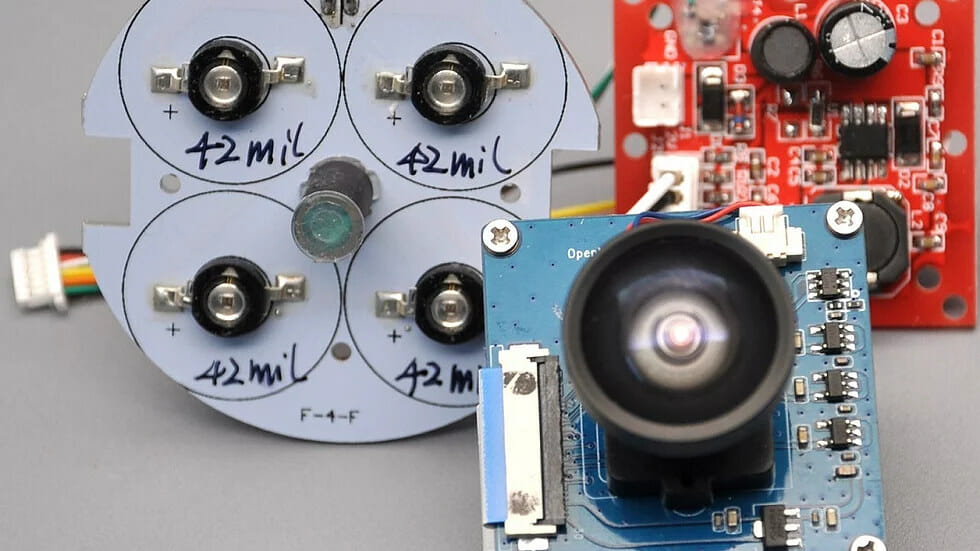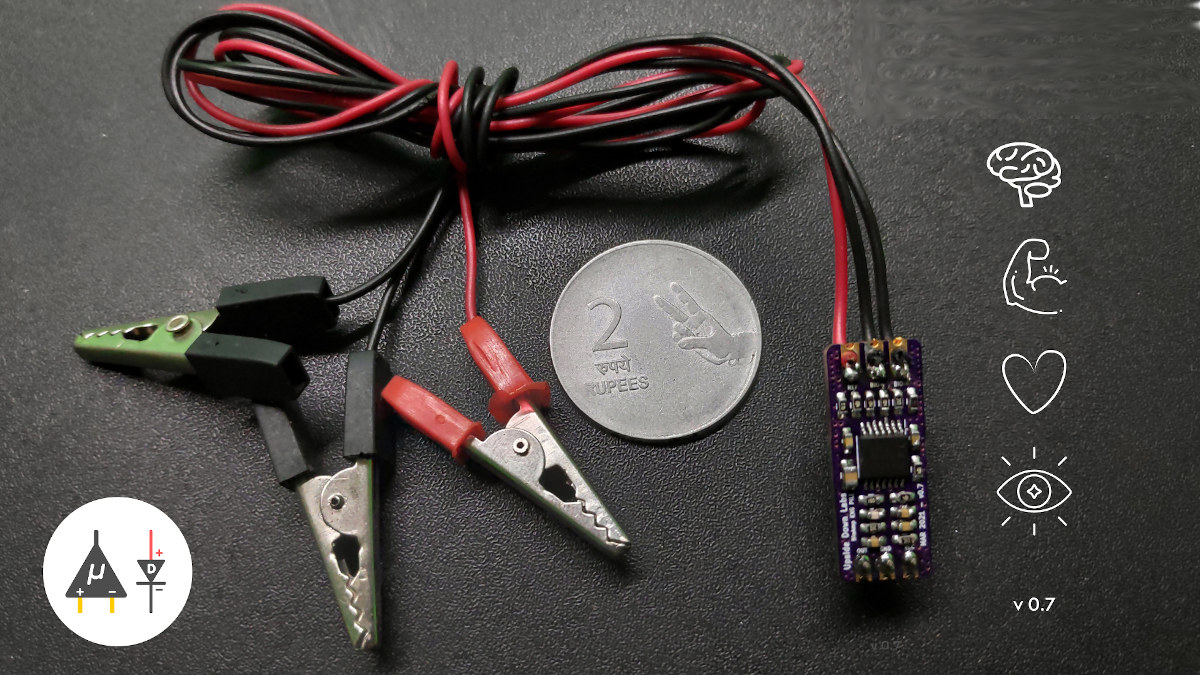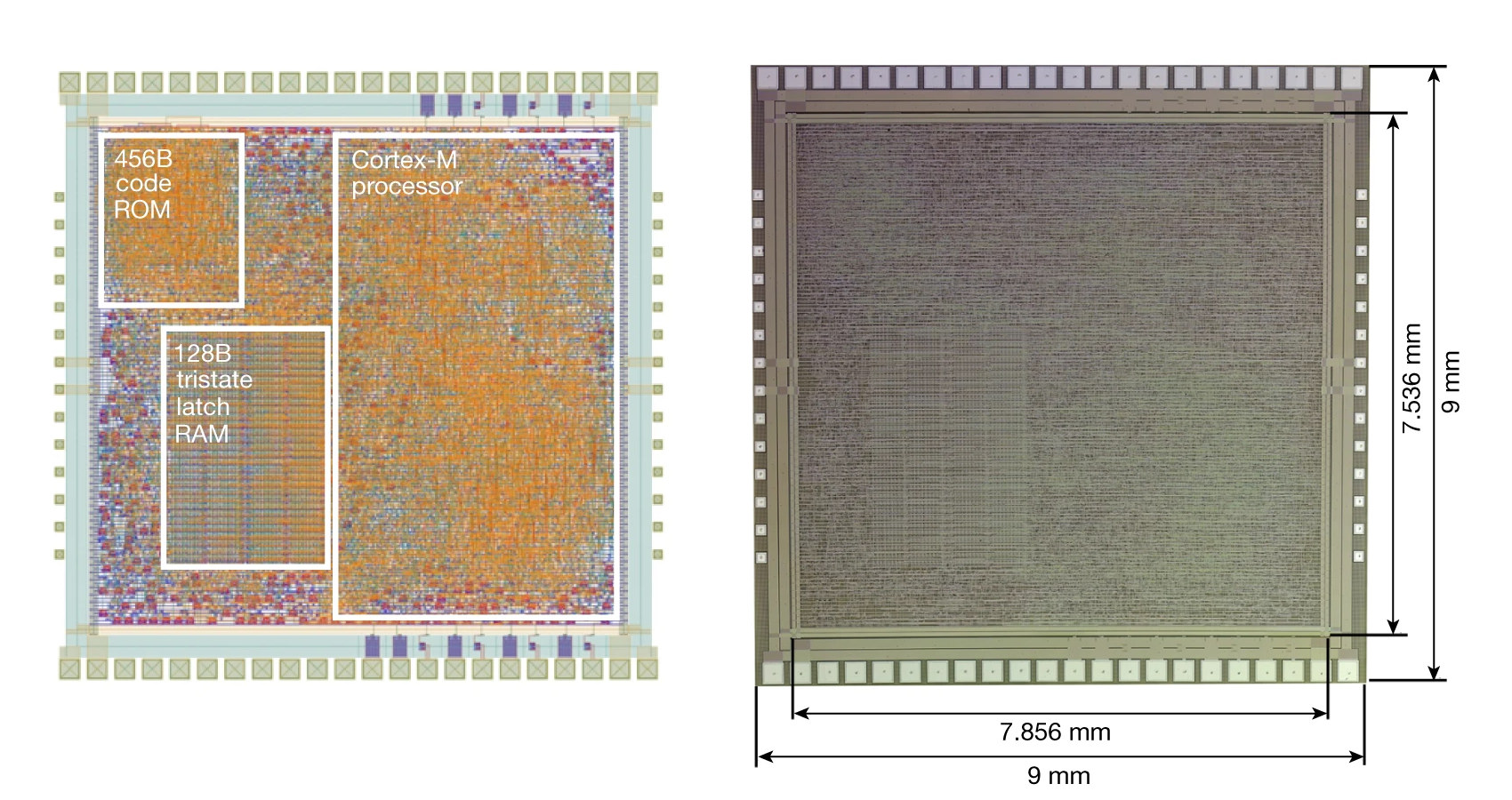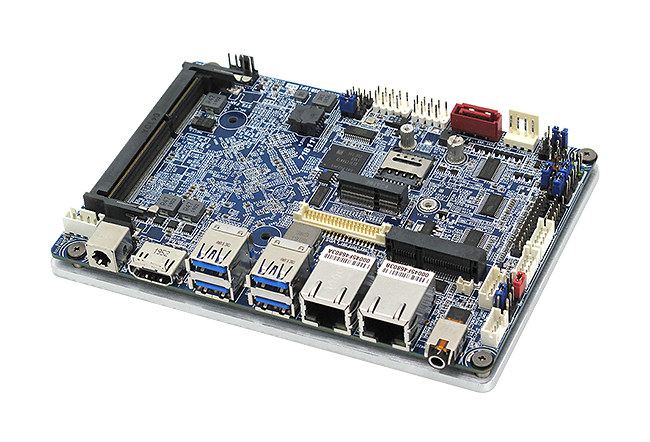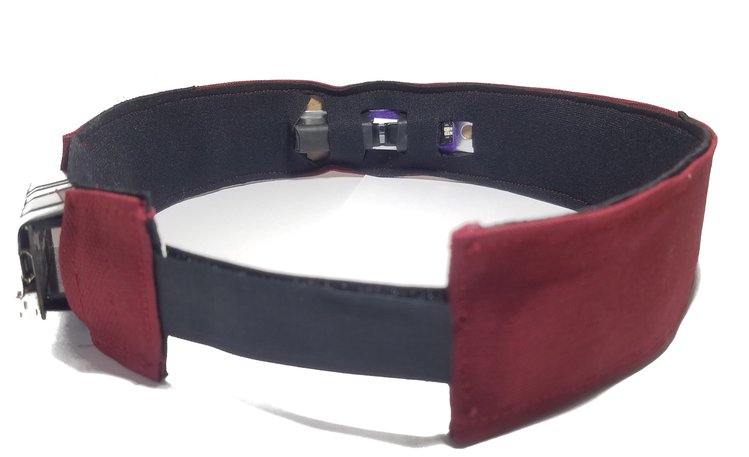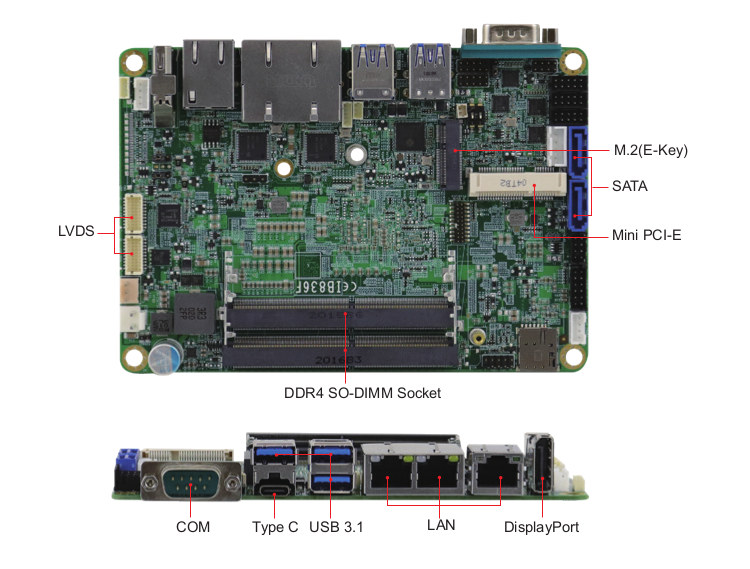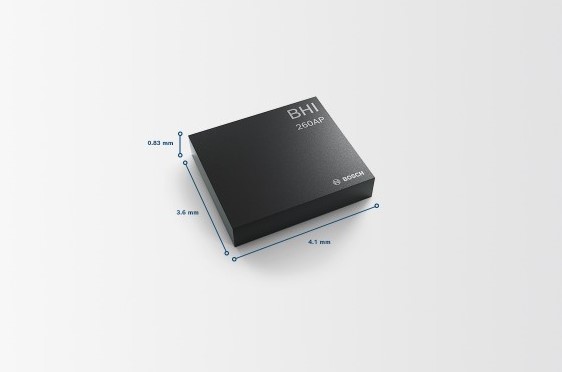We’ve just written about OpenCV Ai Kit Lite computer vision camera based on Intel Myriad X VPU, and OpenNCC Nighthawk is another such programmable camera based on the Intel AI accelerator, but with an IR filter for night vision, and working with OpenNCC-SDK notably supporting real-time face blurring for enhanced privacy. OpenNCC Nighthawk specifications: VPU – Intel Movidius Myriad X MA2085 up to 4 TOPS RAM – 8 Gbits (1GB) LPDDR4 Camera 2MP camera up to 1920 x 1080 @ up to 30fps ~114° Field of View (DFOV) 2.2mm focal length Lens TTL (through the lense) – 24mm Mount – M12 x 0.5mm thread size Day&Night IR Filter – Solenoid excitation type, automatically switch between 0.1~2 lux IR LED – 850nm up to 5m Output Data format – YUV420, YUV422, MJPG, H.264 Misc – Reset, GPIO Host Interface – USB 3.1 TYPE-C port Temperature Range – 0°- 50° The camera […]
BioAmp EXG Pill board enables ECG, EMG, EOG, and EEG biosensing (Crowdfunding)
BioAmp EXG Pill is a small Analog Front End (AFE) biopotential signal-acquisition board designed to be interfaced to any 5V MCU board with an analog-to-digital converter (ADC) such as most Arduino boards, or through a dedicated 5V ADC like the Texas Instruments ADS1115. The board can record biopotential signals like ECG (electrocardiogram), EMG (electromyography), EOG (electrooculography), and EEG (electroencephalogram), or in more simple terms, biosignals from the heart, muscles, eyes, or brain activity. BioAmp EXG Pill key features and specifications: Compatible with any 5V MCU with an ADC Biopotentials: ECG, EOG, EMG, and EEG (configurable) No. of channels: 1 Electrodes: 2 or 3 (configurable) Input Voltage – 5 – 40 V Input Impedance: > 35 MΩ Dimensions – 25.4 x 10 mm OSHWA certifications – IN000026 The board is open-source hardware and you’ll find KiCAD hardware design files like schematics and Gerber files on Github where you’ll also find several […]
PlasticArm is a functional, non-silicon, flexible Cortex-M0 microcontroller
Four years ago, we wrote about PragmatIC’s ultrathin and flexible plastic electronics circuit, with news that an ultra-cheap ARM Cortex M0 MCU made of plastic materials was coming soon. In this case, “soon” means about four years, but Arm has now finally announced PlasticArm, an ultra-minimalist, fully functional Cortex-M0-based SoC, with 128 bytes of RAM and 456 bytes of ROM that, with 18,000 gates, is twelve times more complex than previous state-of-the-art flexible electronics. PlasticArm specifications are similar to a standard Cortex-M0+ core with some notable exceptions: Cortex-M core in PlasticARM ARMv6-M architecture ISA – 16-bit Thunb and subset of 32-bit Thumb 32-bit data access and address width 86 instructions 2-stage pipeline Architectural register file mapped to RAM external to the CPU (instead of inside the CPU) Runs code from other Cortex-M CPUs 0.8-μm process There are two main advantages of PlasticArm. First, It’s flexible and integrated into paper, plastic, […]
3.5-inch SBC targets industrial applications with 9-36V wide-range DC-in
BCM Advanced Research ECM-3455J is an upcoming 3.5-inch SBC designed for industrial application with 9-36V wide range DC-in support, an Intel Celeron J3455 quad-core Apollo Lake processor, up to 8GB SO-DIMM memory, and 32GB on-board eMMC flash. The single board computer also comes with HDMI and LVDS video out, dual Gigabit Ethernet, an M.2 socket a micro SIM socket for cellular connectivity, as well as up to eight USB interfaces, and a thick and large heatspreader for fanless operation. ECM-3455J specifications: SoC – Intel Celeron J3455 quad-core Apollo Lake processor @ 1.5GHz / 2.3GHz (Burst Frequency) with Intel HD graphics 500; 10W TDP System Memory – 1x 204-pin SO-DIMM DDR3L-1600MHz socket for up to 8GB RAM Storage – 32GB eMMC flash (option: 64GB), 1x SATA III port, mSATA socket (See expansion), 64Mbit SPI flash for AMI UEFI BIOS Video Output 18/24-bit dual-channel LVDS through Chrontel CH7511B embedded DisplayPort to LVDS […]
HEGduino V2 supports fNIRS and Blood-Flow Monitoring (Crowdfunding)
AlasKit has launched a crowdfunding campaign on Crowd Supply for HEGduino V2. The device features noninvasive optical imaging through fNIRS (Functional near-infrared spectroscopy), apart from its brain blood flow monitoring functionality. We saw the previous version of the HEGduino in September 2019 which only supported blood flow monitoring. But the HEGduino V2 also monitors breathing, heart rate, and skin temperature. HEGduino V2 has a MAX86141 optical pulse oximeter cum heart-rate sensor for incorporating Heart Rate Variability (HRV) training. It also allows breath and skin temperature monitoring. The sensor has a specification of 2×4096 SPS sensing with a 19-bit resolution which is a bit higher than its previous version. As HEGduino V1 had an 860 SPS sensing with a 16-bit resolution. However, the practical application observes even lesser values for HEGduino V1. Setup of HEGduino V2 The device also comes with an ESP32 breakout board with rechargeable battery support. The board […]
NXP i.MX 9 processors to integrate Arm Ethos U-65 microNPU, EdgeLock secure enclave
NXP i.MX 6 and i.MX 8 processors are widely used in industrial boards and systems-on-module, and the company has now teased a new family with i.MX 9 processors integrating Arm Ethos-U65 1 TOPS microNPU, as well as the company’s EdgeLock secure enclave for increased security. The company did not provide that many technical details, so we still don’t know which CPU cores, GPU, and exact peripherals will be found in the processor. But we do know the i.MX 9 processors will be manufactured with a 16/12nm FinFET class of process technology optimized for low power, and features the “Energy Flex” architecture that combines “heterogeneous domain processing (independent applications processor and real-time domains with a separate low-power multi-media domain), design techniques, and process technology to maximize performance efficiency”. That means most blocks of the processor can be turned off for low power audio or CAN networking use cases, and other industrial […]
3.5-inch Atom x6000E embedded SBC features 3x GbE, 2x SATA, 6x USB, and more
Several Elkhart Lake SBC’s integrate two Ethernet ports including Avalue ECM-EHL 3.5-inch SBC or Congatec Conga-PA7 Pico-ITX board with the former equipped with 2.5GbE and GbE ports, and the latter two GbE ports. But if your industrial project requires more Ethernet ports, iBase IB836 3.5-inch Atom x6000E embedded SBC offers three Gigabit Ethernet RJ45 ports, as well as two SATA ports, six USB interfaces, plus various display options, as well as M.2 and mPCIe expansion sockets. iBase IB836 specifications: Elkhart Lake SoC (one of the other) Intel Atom x6425E quad-core processor @ 1.8GHz/3.0GHz, with 1.5MB cache, Intel UHD graphics; 12W TDP Intel Atom x6413E quad-core processor @ 1.5GHz/3.0GHz, with 1.5MB cache, Intel UHD graphics; 9W TDP Intel Atom x6211E dual-core processor @ 1.2GHz/3.0GHz, with 1.5MB cache, Intel UHD graphics; 6W TDP System Memory – Up to 32GB via DDR4-3200 SO-DIMM, with IBECC support Storage – 2x SATA ports, 1x mSATA […]
BHI260AP is an AI smart sensor with built-in IMU by Bosch Sensortec
BHI260AP AI smart sensor integrates a 6-axis IMU, a 32-bit customizable programmable microcontroller, and various software functionalities. The AI smart sensor has embedded AI with on-sensor applications such as fitness tracking, navigation, machine learning analytics, and orientation estimation. The dimensions of the miniaturized AI smart sensor are 4.1mm x 3.6mm x 0.83 mm. Hardware Features of BHI260AP AI Smart Sensor ARC EM4 CPU includes ARCv2 16/32 bit instruction set working up to a frequency of 3.6 MHz. The core also integrates Floating Point Unit (FPU) and Memory Protection Unit (MPU) with 4 channel micro DMA controller. CPU has two modes of AI functioning at 25Hz and 50Hz with 249µA and 386µA of current consumption respectively. Integrated sensor (6-DoF IMU) includes 16-bit 3 axis accelerometer and 16-bit 3 axis gyroscope. The sensor works at an operating voltage of 1.8 V with a standby current value of 8µA, hence the power consumption […]


